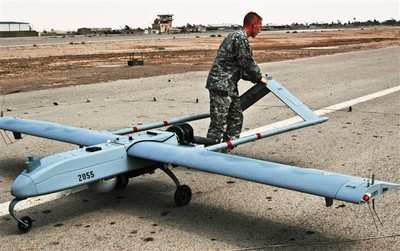Surpasses 1 Million Unmanned Flight Hours
The Army's one millionth Unmanned Aerial System flight hour
marks a window in time through which to view a broader trajectory
of explosive change and expansion -- one in which the advent of
UAVs in Iraq and Afghanistan have added more eyes to the fight,
found and destroyed more enemies and saved more lives -- all the
while altering the way the Army operates on a modern asymmetrical
battlefield.

Predator B UAV
"The ability to have eyes out forward becomes a true combat
multiplier," said Col. Gregory Gonzalez, project manager, Army
UAS.
The growth in UAS since the beginning of OEF and OIF is
staggering -- the Army inventory jumped from a handful of systems
in 2001 to roughly 1,000 aircraft by 2010 and is now logging up to
25,000 of UAV flight hours per month in support of combat
operations in Iraq and Afghanistan. The U.S. Army surpassed the one
million unmanned-hour mark in April of 2010.
"Ninety-five percent of what the Army has in its inventory today
did not even exist at the beginning of the war," said Tim Owings,
deputy program manager, Army UAS. "A lot of people liken Vietnam to
a helicopter war -- I liken these two wars as the unmanned systems
wars because these are the wars where these systems hit the central
axis of the way we fight and became part and parcel to the way the
Army prosecutes wars."
Roughly 900,000 of the one million flight hours have taken place
since the current wars began; it took 13 years to put together the
first 100,000 hours, Owings said. About 88-percent of these flight
hours are from time in combat. At the beginning of the wars in Iraq
and Afghanistan, the Army possessed only a few Shadow and Hunter
UAS Systems. "We had a couple systems at Fort Hood, TX and Fort
Huachuca, AZ. At that time we were flying minimal hours, we were
sort of in the background in terms of big Army. The Army had other
missions and other needs," said Owings.

However, the value of adding electronic "eyes" in the sky to
units conducting counterinsurgency missions on the ground quickly
proved indispensable to the current war effort -- driving a demand
to rapidly multiply the amount of UAS systems produced and
deployed.
The hand-held Raven UAS (above), medium-altitude Extended Range
Multi-Purpose (ERMP) UAS and the hover-and-stare, two-foot long,
vertical take-off gas-powered Micro Air Vehicle (gMAV) are among
the new UAVs added to the fleet in the last seven to eight years;
the Army now operates 87 Shadow UAS systems, 6 Hunter systems, 9
ERMP variants, 1,300 Raven systems and 16 gMAV systems.
A Quick Reaction Capability (QRC) of four ERMP aircraft were
deployed to Iraq last year --and another ERMP QRC is slated for
Afghanistan later this year. The ERMPs heading to Afghanistan will
be armed with Hellfire missiles under each wing. The idea of the
QRC is to field technologies in service of the ongoing war effort
as they are available while simultaneously developing a system as a
program of record, Gonzalez said.
The rapid addition of hundreds of UAVs to wars in Iraq and
Afghanistan has lead to innovations such as communications relay
and the use of manned-unmanned teaming wherein helicopter pilots
work in tandem with nearby UAS assets.

Shadow UAV
"Manned aircraft and scout aircraft are limited by how long the
pilots can stay up there. When you start to add a day and night
capability [with UAS] that can stay up for extended periods, you
can keep an eye on a lot more. Then, you can call in the manned
aircraft to take out a target," said Gonzalez. "Pilots have not
only embraced the concept but they are trying to get more
manned/unmanned teaming."
UAS minimize risk to pilots by flying into "hot" areas ahead of
helicopters; they can even function as a communication node on a
network connected forces separated by terrain. "If there are ground
units separated by mountain ranges, we can allow two ground units
to talk to each other through UAS --- pass voice coms and data coms
over terrain which would typically cause radio obscurance," said
Owings.

Global Hawk UAV
Along these lines, the Army now operates Manned-Unmanned Teaming
technology in which gives Apache pilots the ability to view
real-time UAV feeds from within the cockpit of the aircraft.
The Army is testing the next-generation of this technology which
allows the pilots to not only view the UAV feeds in the cockpit but
direct their flight and payloads as well. The Army's
now-in-development next-generation Block III Apache is involved in
a pilot program testing this cutting-edge capability.
 ANN's Daily Aero-Linx (04.15.24)
ANN's Daily Aero-Linx (04.15.24) Classic Aero-TV: 'No Other Options' -- The Israeli Air Force's Danny Shapira
Classic Aero-TV: 'No Other Options' -- The Israeli Air Force's Danny Shapira Aero-News: Quote of the Day (04.15.24)
Aero-News: Quote of the Day (04.15.24) Airborne 04.16.24: RV Update, Affordable Flying Expo, Diamond Lil
Airborne 04.16.24: RV Update, Affordable Flying Expo, Diamond Lil ANN's Daily Aero-Term (04.16.24): Chart Supplement US
ANN's Daily Aero-Term (04.16.24): Chart Supplement US






